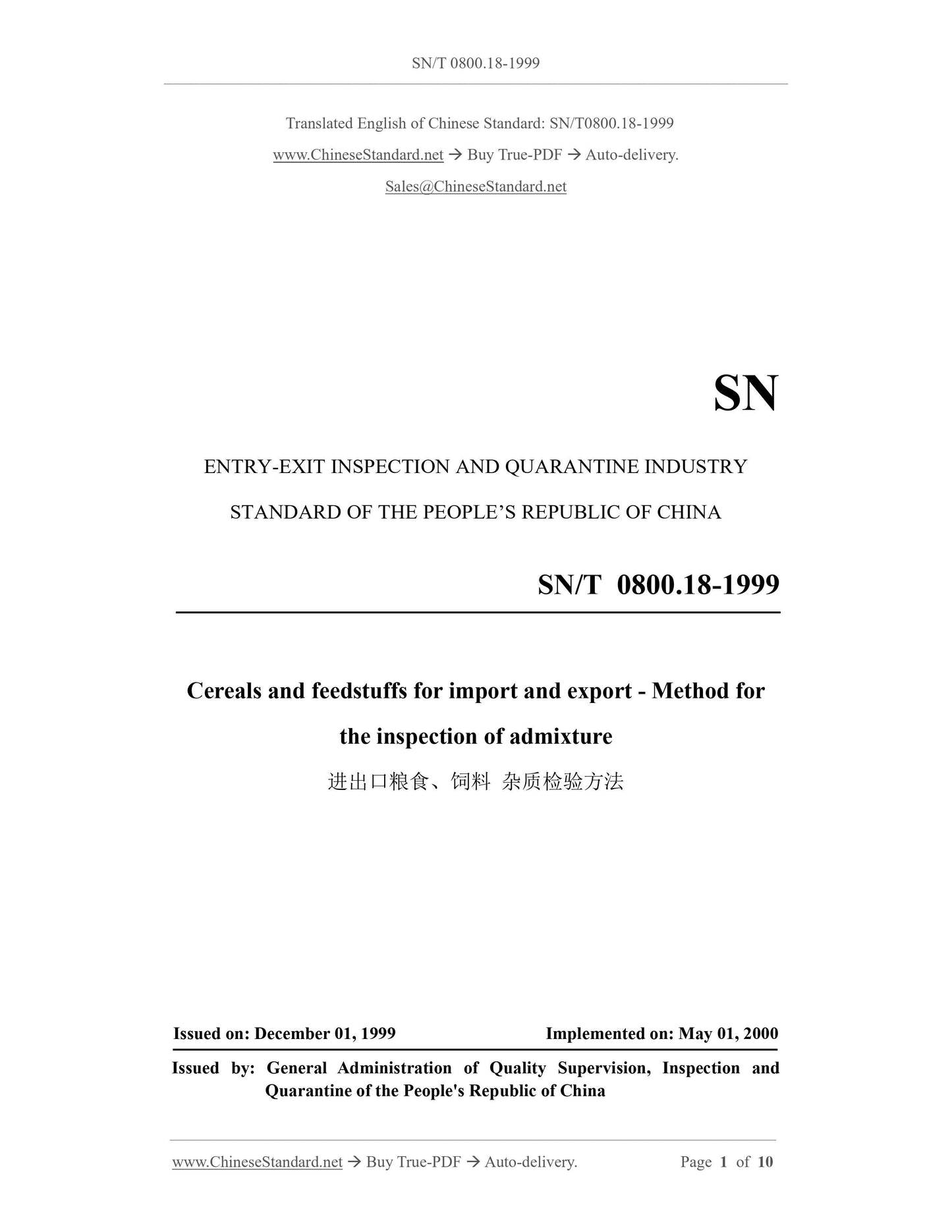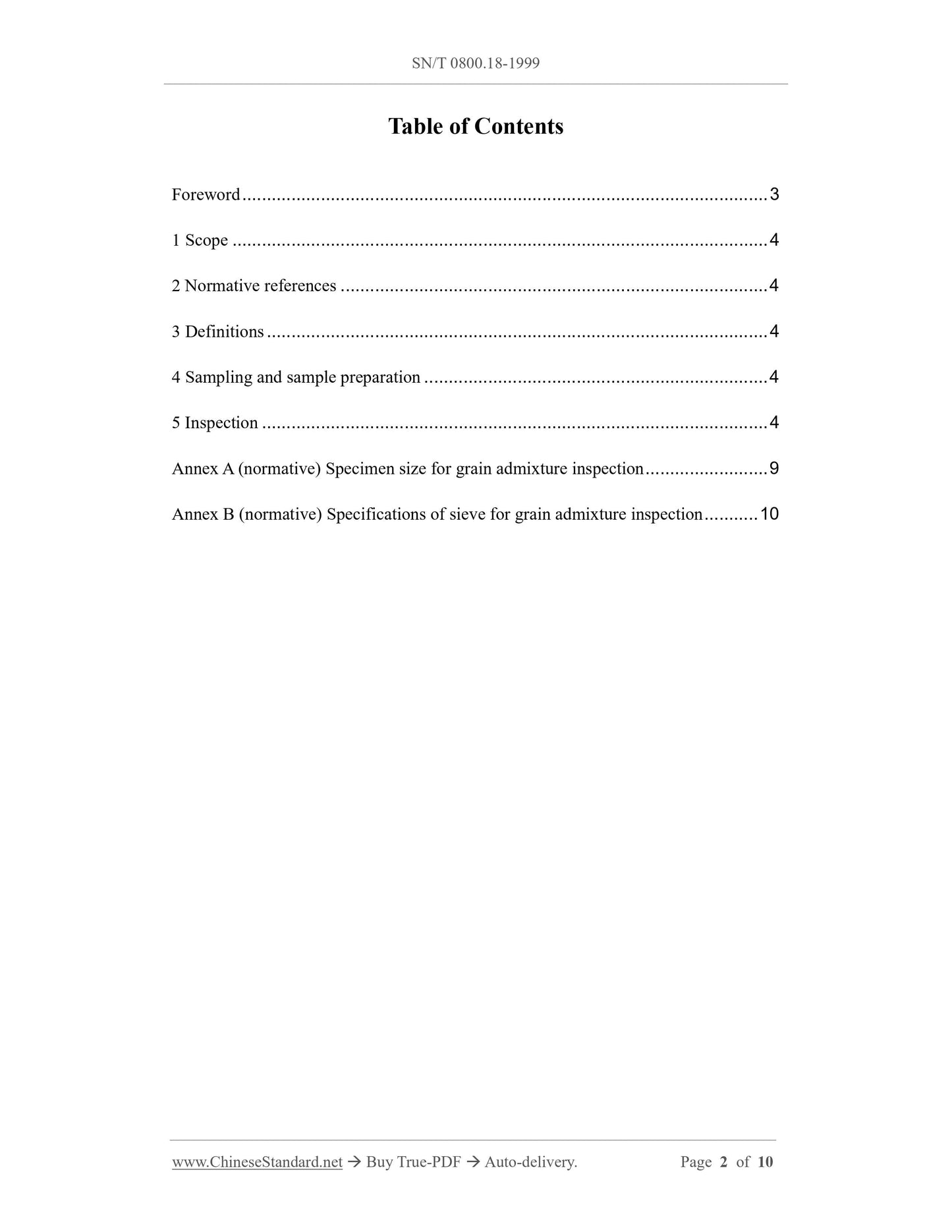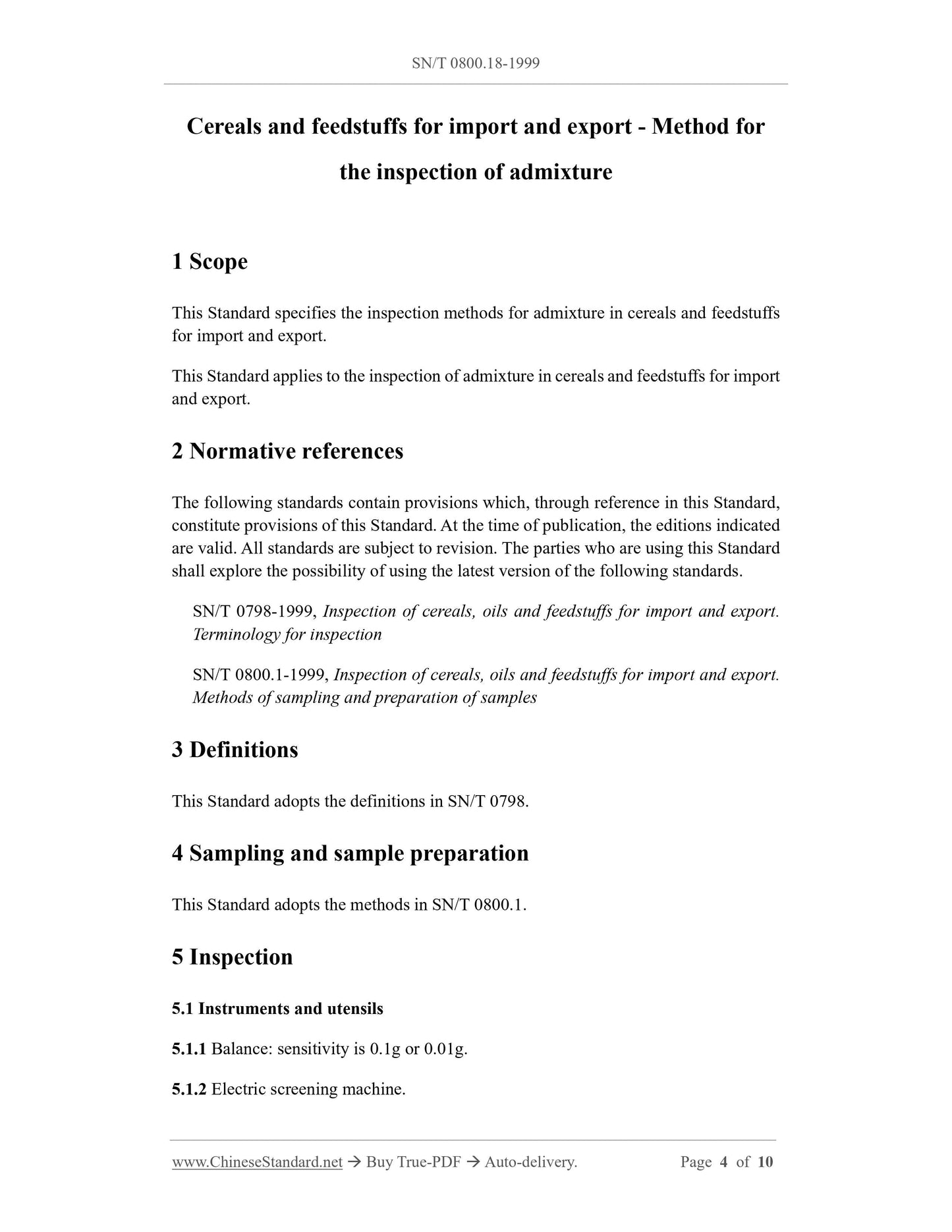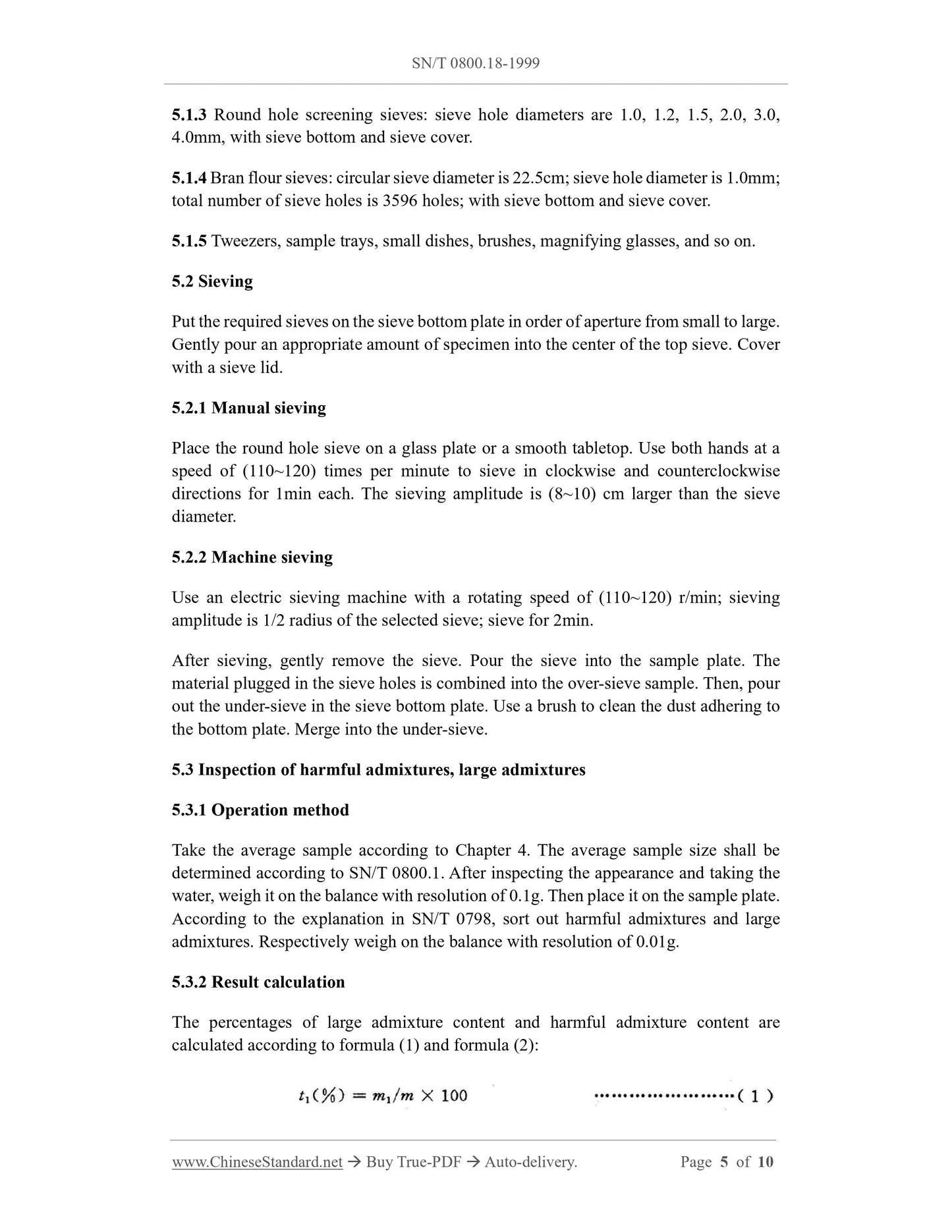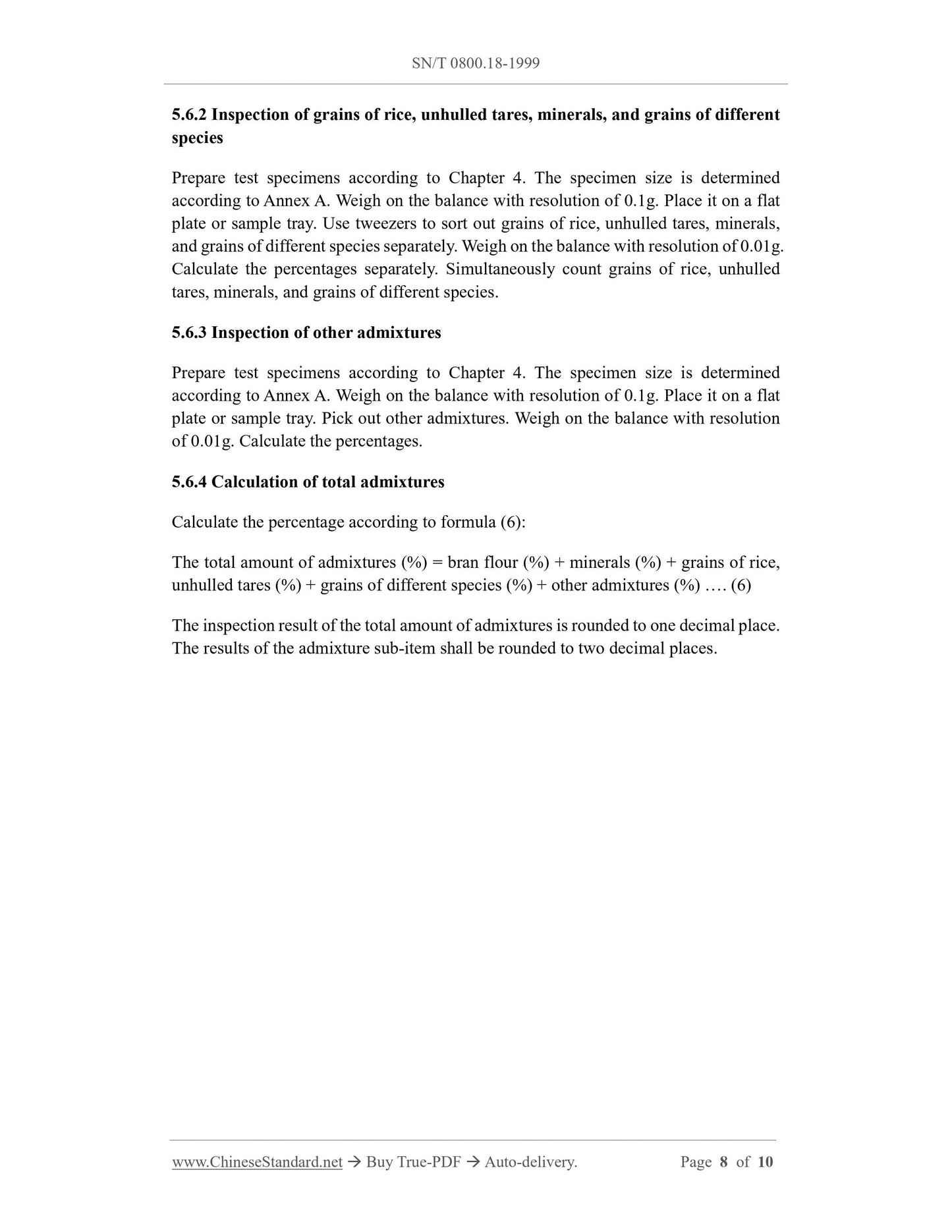1
/
of
5
PayPal, credit cards. Download editable-PDF & invoice in 1 second!
SN/T 0800.18-1999 English PDF (SNT0800.18-1999)
SN/T 0800.18-1999 English PDF (SNT0800.18-1999)
Regular price
$110.00 USD
Regular price
Sale price
$110.00 USD
Unit price
/
per
Shipping calculated at checkout.
Couldn't load pickup availability
Delivery: 3 seconds. Download true-PDF + Invoice.
Get QUOTATION in 1-minute: Click SN/T 0800.18-1999
Historical versions: SN/T 0800.18-1999
Preview True-PDF (Reload/Scroll if blank)
SN/T 0800.18-1999: Cereals and feedstuffs for import and export. Method for the inspection of admixture
SN/T 0800.18-1999
SN
ENTRY-EXIT INSPECTION AND QUARANTINE INDUSTRY
STANDARD OF THE PEOPLE’S REPUBLIC OF CHINA
Cereals and feedstuffs for import and export - Method for
the inspection of admixture
ISSUED ON: DECEMBER 01, 1999
IMPLEMENTED ON: MAY 01, 2000
Issued by: General Administration of Quality Supervision, Inspection and
Quarantine of the People's Republic of China
Table of Contents
Foreword ... 3
1 Scope ... 4
2 Normative references ... 4
3 Definitions ... 4
4 Sampling and sample preparation ... 4
5 Inspection ... 4
Annex A (normative) Specimen size for grain admixture inspection ... 9
Annex B (normative) Specifications of sieve for grain admixture inspection ... 10
Cereals and feedstuffs for import and export - Method for
the inspection of admixture
1 Scope
This Standard specifies the inspection methods for admixture in cereals and feedstuffs
for import and export.
This Standard applies to the inspection of admixture in cereals and feedstuffs for import
and export.
2 Normative references
The following standards contain provisions which, through reference in this Standard,
constitute provisions of this Standard. At the time of publication, the editions indicated
are valid. All standards are subject to revision. The parties who are using this Standard
shall explore the possibility of using the latest version of the following standards.
SN/T 0798-1999, Inspection of cereals, oils and feedstuffs for import and export.
Terminology for inspection
SN/T 0800.1-1999, Inspection of cereals, oils and feedstuffs for import and export.
Methods of sampling and preparation of samples
3 Definitions
This Standard adopts the definitions in SN/T 0798.
4 Sampling and sample preparation
This Standard adopts the methods in SN/T 0800.1.
5 Inspection
5.1 Instruments and utensils
5.1.1 Balance: sensitivity is 0.1g or 0.01g.
5.1.2 Electric screening machine.
5.1.3 Round hole screening sieves: sieve hole diameters are 1.0, 1.2, 1.5, 2.0, 3.0,
4.0mm, with sieve bottom and sieve cover.
5.1.4 Bran flour sieves: circular sieve diameter is 22.5cm; sieve hole diameter is 1.0mm;
total number of sieve holes is 3596 holes; with sieve bottom and sieve cover.
5.1.5 Tweezers, sample trays, small dishes, brushes, magnifying glasses, and so on.
5.2 Sieving
Put the required sieves on the sieve bottom plate in order of aperture from small to large.
Gently pour an appropriate amount of specimen into the center of the top sieve. Cover
with a sieve lid.
5.2.1 Manual sieving
Place the round hole sieve on a glass plate or a smooth tabletop. Use both hands at a
speed of (110~120) times per minute to sieve in clockwise and counterclockwise
directions for 1min each. The sieving amplitude is (8~10) cm larger than the sieve
diameter.
5.2.2 Machine sieving
Use an electric sieving machine with a rotating speed of (110~120) r/min; sieving
amplitude is 1/2 radius of the selected sieve; sieve for 2min.
After sieving, gently remove the sieve. Pour the sieve into the sample plate. The
material plugged in the sieve holes is combined into the over-sieve sample. Then, pour
out the under-sieve in the sieve bottom plate. Use a brush to clean the dust adhering to
the bottom plate. Merge into the under-sieve.
5.3 Inspection of harmful admixtures, large admixtures
5.3.1 Operation method
Take the average sample according to Chapter 4. The average sample size shall be
determined according to SN/T 0800.1. After inspecting the appearance and taking the
water, weigh it on the balance with resolution of 0.1g. Then place it on the sample plate.
According to the explanation in SN/T 0798, sort out harmful admixtures and large
admixtures. Respectively weigh on the balance with resolution of 0.01g.
5.3.2 Result calculation
The percentages of large admixture content and harmful admixture content are
calculated according to formula (1) and formula (2):
5.6.2 Inspection of grains of rice, unhulled tares, minerals, and grains of different
species
Prepare test specimens according to Chapter 4. The specimen size is determined
according to Annex A. Weigh on the balance with resolution of 0.1g. Place it on a flat
plate or sample tray. Use tweezers to sort out grains of rice, unhulled tares, minerals,
and grains of different species separately. Weigh on the balance with resolution of 0.01g.
Calculate the percentages separately. Simultaneously count grains of rice, unhulled
tares, minerals, and grains of different species.
5.6.3 Inspection of other admixtures
Prepare test specimens according to Chapter 4. The specimen size is determined
according to Annex A. Weigh on the balance with resolution of 0.1g. Place it on a flat
plate or sample tray. Pick out other admixtures. Weigh on the balance with resolution
of 0.01g. Calculate the percentages.
5.6.4 Calculation of total admixtures
Calculate the percentage according to formula (6):
The total amount of admixtures (%) = bran flour (%) + minerals (%) + grains of rice,
unhulled tares (%) + grains of different species (%) + other admixtures (%) …. (6)
The inspection result of the total amount of admixtures is rounded to one decimal place.
The results of the admixture sub-item shall be rounded to two decimal places.
Get QUOTATION in 1-minute: Click SN/T 0800.18-1999
Historical versions: SN/T 0800.18-1999
Preview True-PDF (Reload/Scroll if blank)
SN/T 0800.18-1999: Cereals and feedstuffs for import and export. Method for the inspection of admixture
SN/T 0800.18-1999
SN
ENTRY-EXIT INSPECTION AND QUARANTINE INDUSTRY
STANDARD OF THE PEOPLE’S REPUBLIC OF CHINA
Cereals and feedstuffs for import and export - Method for
the inspection of admixture
ISSUED ON: DECEMBER 01, 1999
IMPLEMENTED ON: MAY 01, 2000
Issued by: General Administration of Quality Supervision, Inspection and
Quarantine of the People's Republic of China
Table of Contents
Foreword ... 3
1 Scope ... 4
2 Normative references ... 4
3 Definitions ... 4
4 Sampling and sample preparation ... 4
5 Inspection ... 4
Annex A (normative) Specimen size for grain admixture inspection ... 9
Annex B (normative) Specifications of sieve for grain admixture inspection ... 10
Cereals and feedstuffs for import and export - Method for
the inspection of admixture
1 Scope
This Standard specifies the inspection methods for admixture in cereals and feedstuffs
for import and export.
This Standard applies to the inspection of admixture in cereals and feedstuffs for import
and export.
2 Normative references
The following standards contain provisions which, through reference in this Standard,
constitute provisions of this Standard. At the time of publication, the editions indicated
are valid. All standards are subject to revision. The parties who are using this Standard
shall explore the possibility of using the latest version of the following standards.
SN/T 0798-1999, Inspection of cereals, oils and feedstuffs for import and export.
Terminology for inspection
SN/T 0800.1-1999, Inspection of cereals, oils and feedstuffs for import and export.
Methods of sampling and preparation of samples
3 Definitions
This Standard adopts the definitions in SN/T 0798.
4 Sampling and sample preparation
This Standard adopts the methods in SN/T 0800.1.
5 Inspection
5.1 Instruments and utensils
5.1.1 Balance: sensitivity is 0.1g or 0.01g.
5.1.2 Electric screening machine.
5.1.3 Round hole screening sieves: sieve hole diameters are 1.0, 1.2, 1.5, 2.0, 3.0,
4.0mm, with sieve bottom and sieve cover.
5.1.4 Bran flour sieves: circular sieve diameter is 22.5cm; sieve hole diameter is 1.0mm;
total number of sieve holes is 3596 holes; with sieve bottom and sieve cover.
5.1.5 Tweezers, sample trays, small dishes, brushes, magnifying glasses, and so on.
5.2 Sieving
Put the required sieves on the sieve bottom plate in order of aperture from small to large.
Gently pour an appropriate amount of specimen into the center of the top sieve. Cover
with a sieve lid.
5.2.1 Manual sieving
Place the round hole sieve on a glass plate or a smooth tabletop. Use both hands at a
speed of (110~120) times per minute to sieve in clockwise and counterclockwise
directions for 1min each. The sieving amplitude is (8~10) cm larger than the sieve
diameter.
5.2.2 Machine sieving
Use an electric sieving machine with a rotating speed of (110~120) r/min; sieving
amplitude is 1/2 radius of the selected sieve; sieve for 2min.
After sieving, gently remove the sieve. Pour the sieve into the sample plate. The
material plugged in the sieve holes is combined into the over-sieve sample. Then, pour
out the under-sieve in the sieve bottom plate. Use a brush to clean the dust adhering to
the bottom plate. Merge into the under-sieve.
5.3 Inspection of harmful admixtures, large admixtures
5.3.1 Operation method
Take the average sample according to Chapter 4. The average sample size shall be
determined according to SN/T 0800.1. After inspecting the appearance and taking the
water, weigh it on the balance with resolution of 0.1g. Then place it on the sample plate.
According to the explanation in SN/T 0798, sort out harmful admixtures and large
admixtures. Respectively weigh on the balance with resolution of 0.01g.
5.3.2 Result calculation
The percentages of large admixture content and harmful admixture content are
calculated according to formula (1) and formula (2):
5.6.2 Inspection of grains of rice, unhulled tares, minerals, and grains of different
species
Prepare test specimens according to Chapter 4. The specimen size is determined
according to Annex A. Weigh on the balance with resolution of 0.1g. Place it on a flat
plate or sample tray. Use tweezers to sort out grains of rice, unhulled tares, minerals,
and grains of different species separately. Weigh on the balance with resolution of 0.01g.
Calculate the percentages separately. Simultaneously count grains of rice, unhulled
tares, minerals, and grains of different species.
5.6.3 Inspection of other admixtures
Prepare test specimens according to Chapter 4. The specimen size is determined
according to Annex A. Weigh on the balance with resolution of 0.1g. Place it on a flat
plate or sample tray. Pick out other admixtures. Weigh on the balance with resolution
of 0.01g. Calculate the percentages.
5.6.4 Calculation of total admixtures
Calculate the percentage according to formula (6):
The total amount of admixtures (%) = bran flour (%) + minerals (%) + grains of rice,
unhulled tares (%) + grains of different species (%) + other admixtures (%) …. (6)
The inspection result of the total amount of admixtures is rounded to one decimal place.
The results of the admixture sub-item shall be rounded to two decimal places.
Share
